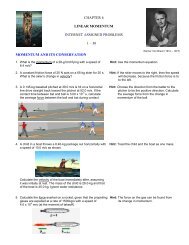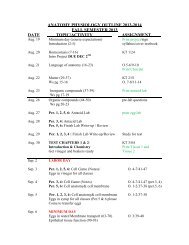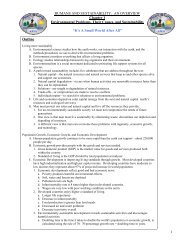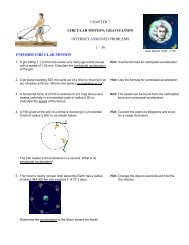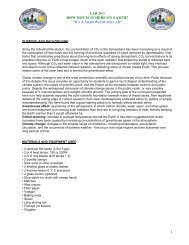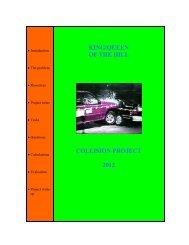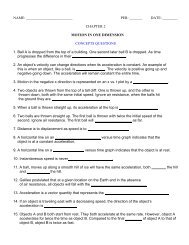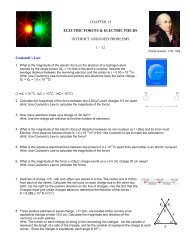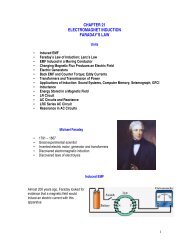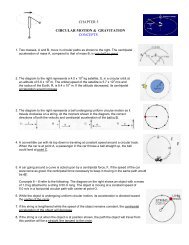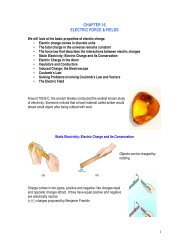CHAPTER 4 Dynamics: Newton's Laws of Motion - Physics-matters.net
CHAPTER 4 Dynamics: Newton's Laws of Motion - Physics-matters.net
CHAPTER 4 Dynamics: Newton's Laws of Motion - Physics-matters.net
Create successful ePaper yourself
Turn your PDF publications into a flip-book with our unique Google optimized e-Paper software.
<strong>CHAPTER</strong> 4<strong>Dynamics</strong>:Newton’s <strong>Laws</strong> <strong>of</strong> <strong>Motion</strong>http://www.physicsclassroom.com/Class/newtlaws/newtltoc.html• Force• Newton’s First Law <strong>of</strong> <strong>Motion</strong>• Mass• Newton’s Second Law <strong>of</strong> <strong>Motion</strong>• Newton’s Third Law <strong>of</strong> <strong>Motion</strong>• Weight – the Force <strong>of</strong> Gravity; and the Normal Force• Solving Problems with Newton’s <strong>Laws</strong>: Free-Body Diagrams• Applications Involving Friction, Inclines• Problem Solving – A General ApproachClassical Mechanics• Describes the relationship between the motion <strong>of</strong> objects in our everyday world and theforces acting on them• Conditions when Classical Mechanics does not apply– very tiny objects (< atomic sizes)– objects moving near the speed <strong>of</strong> lightForces• Usually think <strong>of</strong> a force as a push or pull• Vector quantity• May be a contact force or a field force– Contact forces result from physical contact between two objects– Field forces act between disconnected objects• Also called “action at a distance”Contact and Field Forces1
Fundamental Forces• Types– Strong nuclear force– Electromag<strong>net</strong>ic force– Weak nuclear force– Gravity• Characteristics– All field forces– Listed in order <strong>of</strong> decreasing strength– Only gravity and electromag<strong>net</strong>ic in mechanicsSir Isaac Newton• 1642 – 1727• Formulated basic concepts and laws <strong>of</strong> mechanics• Universal Gravitation• Calculus• Light and opticsNewton’s First Law <strong>of</strong> <strong>Motion</strong>Newton’s first law is <strong>of</strong>ten called the law <strong>of</strong> inertia.Every object continues in its state <strong>of</strong> rest, or <strong>of</strong>uniform velocity in a straight line, as long as no<strong>net</strong> force acts on it.External and Internal Forces• External force– Any force that results from the interaction between the object and its environment• Internal forces– Forces that originate within the object itself– They cannot change the object’s velocity2
InertiaIs the tendency <strong>of</strong> an object to continue in its original motion.MassMass is the measure <strong>of</strong> inertia <strong>of</strong> an object. In the SI system, mass is measured in kilograms.Mass is not weight: Mass is a property <strong>of</strong> an object. Weight is the force exerted on that object bygravity.If you go to the moon, whose gravitational acceleration is about 1/6 g, you will weigh much less.Your mass, however, will be the same.Newton’s Second Law <strong>of</strong> <strong>Motion</strong>Newton’s second law is the relation between acceleration andforce. Acceleration is proportional to force and inverselyproportional to mass.∑ F =ma• SI unit <strong>of</strong> force is a Newton (N)1N≡1 kg m2sUnits <strong>of</strong> Force• US Customary unit <strong>of</strong> force is a pound (lb)– 1 N = 0.225 lbForce is a vector, so ∑ F = ma is true along each coordinateaxis.The unit <strong>of</strong> force in the SI system is the newton (N).Note that the pound is a unit <strong>of</strong> force, not <strong>of</strong> mass, and cantherefore be equated to newtons but not to kilograms.3
Example 1: What average <strong>net</strong> force is required to bring a 1500-kg car to rest from a speed <strong>of</strong> 100km/h within a distance <strong>of</strong> 55 m?2 2v = v + 2 a( x−x)oo2 2 2( v − vo) 0 − (28 m/ s)a = = =−7.1 m/s2( x−x ) 2(55 m)oF ma2(1500 kg)( 7.1 m/ s )41.1x10N∑ = = − =−2Example 2: An airboat with mass 350 kg,including passengers, has an engine thatproduces a <strong>net</strong> horizontal force <strong>of</strong> 710 N,after accounting for forces <strong>of</strong> resistance.(a) Find the acceleration <strong>of</strong> the airboat.F 770NF = ma→ a = = = 2.20 m/sm 350kg(b) Starting from rest, how long does it take the airboat to reach a speed <strong>of</strong> 12.0m/s?v= vo+ at212.0 m/ s = 0 + (2.20 m/ s ) t → t = 5.45s2(c) After reaching this speed, the pilot turns <strong>of</strong>f the engine and drifts to a stop over a distance <strong>of</strong>50.0 m. Find the resistance force, assuming it’s constant.v − v = 2aΔx2 2o0 − (12 m/ s) = 2 a(50.0 m) → a =−1.44 m/sF ma kg m s2 22resis tan ce= = (350 )( − 1.44 / ) =−504N4
Example 3: What happens when a person pulls upward on a boxwith a force <strong>of</strong> 100N? The box has a weight <strong>of</strong> mg = 98N.∑ F = F − mg = 100N − 98N = 2.0NyPay∑ Fy2.0N= = = 0.20 m/sm 10.0kg21kg = 9.80NExample 4: Calculate the sum <strong>of</strong> the two forcesexerted on the boat by workers A and B.The components <strong>of</strong> F AoF = F cos 45.0 = (40.0 N)(0.707) = 28.3NAXAoF = F sin 45.0 = (40.0 N)(0.707) = 28.3NAYAThe components <strong>of</strong> F BoF =+ F cos37.0 =+ (30.0 N)(0.799) =+ 24.0NBXBoF =− F sin 37.0 =− (30.0 N)(0.602) =−18.1NBYBThe components <strong>of</strong> the resultant force areFRX = FAX + FBX= 28.3N + 24.0N= 52.3NF = F + F = 28.3N − 18.1N = 10.2NRY AY BYThe magnitude <strong>of</strong> the resultant force:F = F + F = (52.3 N) + (10.2 N) = 53.3N2 2 2 2R RX RYThe angle that the <strong>net</strong> force makes with the x axis:10.2tan θ = FRYN0.195F= 52.3N= −tan 1 (0.195)=11.0oRX5
The weight <strong>of</strong> an object on the Earth’s surface isthe gravitational force exerted on it by the Earth.Apparent weight:Your perception <strong>of</strong> your weight is based on thecontact forces between your body and yoursurroundings.WeightIf your surroundings are accelerating, yourapparent weight may be more or less than youractual weight.Weight – the Force <strong>of</strong> Gravity; and the Normal ForceAn object at rest must have no <strong>net</strong> force on it. If it is sitting on a table, theforce <strong>of</strong> gravity is still there; what other force is there?The force exerted perpendicular to a surface is called the normal force. Itis exactly as large as needed to balance the force from the object (if therequired force gets too big, something breaks!)Action-Reaction PairsN is the normal force, the force the table exerts on theTV.N is always perpendicular to the surfaceF g is the force the Earth exerts on the object.F g is always straight down regardless <strong>of</strong> the angle <strong>of</strong> theobject.7
The normal force may be equal to, greaterthan, or less than the weight.Normal ForcesThe normal force is always perpendicular to thesurface.Free Body Diagram• Must identify all the forces acting on the object <strong>of</strong>interest• Choose an appropriate coordinate system• If the free body diagram is incorrect, the solution willlikely be incorrect• The force T is the tension acting on the box– The tension is the same at all points along therope • n and Fgare the forces exerted by the earth and theground• Only forces acting directly on the object are included in the free body diagram– Reaction forces act on other objects and so are not included– The reaction forces do not directly influence the object’s motionSolving Newton’s Second Law Problems• Read the problem at least once• Draw a picture <strong>of</strong> the system– Identify the object <strong>of</strong> primary interest– Indicate forces with arrows• Label each force– Use labels that bring to mind the physical quantity involved8
• Draw a free body diagram– If additional objects are involved, draw separate free body diagrams for eachobject– Choose a convenient coordinate system for each object• Apply Newton’s Second Law– The x- and y-components should be taken from the vector equation and writtenseparately• Solve for the unknown(s)Equilibrium• An object either at rest or moving with a constant velocity is said to be in equilibrium• The <strong>net</strong> force acting on the object is zero (since the acceleration is zero)• Easier to work with the equation in terms <strong>of</strong> its components:F = 0 and F = 0∑x∑• This could be extended to three dimensionsyExample 6: A traffic light weighing 100N hangs from a verticalcable tied to two other cables that are fastened to a support. Theupper cables make angles <strong>of</strong> 37.0 o and 53.0 o with thehorizontal. Find the tension in each <strong>of</strong> the three cables.T3 = Fg= 100NTo resolve all three tension forces into components develop thefollowing table:Force x-component y-componentooT1−T1cos37.0 T1sin 37.0ooT2T2cos53.0 T2sin 53.0T0−100N3Apply the conditions for equilibrium to the knot, using the components<strong>of</strong> the table:o9∑ FX=− T1cos37.0 + T2cos53.0 = 0oo∑ Fy= T1sin 37.0 + T2sin 53.0 − 100N= 0There are two equations and two remaining unknowns. Solve equation1 for :o⎛cos37.0 ⎞ ⎛0.799⎞T2 = T1⎜ T11.33To ⎟= ⎜ ⎟=1⎝cos53.0 ⎠ ⎝0.602⎠9
Substitute the result forT 2into equation 2:oT sin 37.0 + (1.33 T)(sin 53.0 ) − 100N= 0o1 1T = 60.1N1T = 1.33T = 1.33(60.1 N) = 79.9N2 1Inclined Planes• Choose the coordinate system with x along the inclineand y perpendicular to the incline• Replace the force <strong>of</strong> gravity with its componentsExample 7: A sled is held at rest on a frictionless, snowcoveredhill. If the sled weighs 77.0 N, find the force exerted bythe rope on the sled and the magnitude <strong>of</strong> the force n exertedby the hill on the sled.Apply Newton’s 2 nd law to the sled, with a = 0:Find the x-component, normal force = 0 ∑ F = T + n+ F g= 0o∑ F = T + 0 − mgsin θ = T − (77.0 N)sin 30.0 = 0T = 38.5NoFind the y-component, there is a normal force ∑ FY= 0 + n− mgcos θ = n− (77.0 N)(cos30.0 ) = 0n=66.7NX• When you have more than one object,the problem-solving strategy is appliedto each object• Draw free body diagrams for eachobject• Apply Newton’s <strong>Laws</strong> to each object• Solve the equationsMultiple Objects – Example10
Forces <strong>of</strong> Friction• When an object is in motion on a surface or through a viscousmedium, there will be a resistance to the motion– This is due to the interactions between the object andits environment• This is resistance is called friction• Friction is proportional to the normal force• The force <strong>of</strong> static friction is generally greater than the force<strong>of</strong> ki<strong>net</strong>ic friction• The coefficient <strong>of</strong> friction (µ) depends on the surfaces incontact• The direction <strong>of</strong> the frictional force is opposite the direction <strong>of</strong>motion• The coefficients <strong>of</strong> friction are nearly independent <strong>of</strong> the area<strong>of</strong> contactStatic Friction, ƒ s• Static friction acts to keep the object from moving• If F increases, so does ƒ s• If F decreases, so does ƒ s• ƒ s ≤ µ nKi<strong>net</strong>ic Friction, ƒ k• The force <strong>of</strong> ki<strong>net</strong>ic friction acts when the object is in motion• ƒ k = µ n– Variations <strong>of</strong> the coefficient with speed will be ignored11
Block on a Ramp, Example• Axes are rotated as usual on an incline• The direction <strong>of</strong> impending motion would bedown the plane• Friction acts up the plane– Opposes the motion• Apply Newton’s <strong>Laws</strong> and solve equationsExample 8: A block is launched up a frictionlessincline in the diagram to the right with an initialvelocity <strong>of</strong> 5.5 m/s. What is the maximumdisplacement, d, <strong>of</strong> the block up the incline?2 2vo(5.5 m/ s)D= = = 2.4m2o2gsinθ2(9.80 m/ s )(sin 40 )Example 9: The block shown on the right remains at rest.What is the friction force acting on the block?2F = ma F = (0.50 kg)(9.80 m/ s ) = 4.9NoFfr= 4.9Nsin 40 = 3.1NExample 10: A hockey puck is struck by a hockey stick andgiven an initial speed <strong>of</strong> 20.0 m/s. The puck remains on the iceand slides 120 m, slowing down steadily until it comes to a rest.Determine the coefficient <strong>of</strong> ki<strong>net</strong>ic friction between the puckand the ice.2 2v = vo+ 2aΔx20 − (20.0 m/ s)2a = =−1.67 m/s2(120 m)2a 1.67 m/sμk=− = = 0.1702g 9.80 m/s12
Connected Objects• Apply Newton’s <strong>Laws</strong> separately to each object• The magnitude <strong>of</strong> the acceleration <strong>of</strong> both objects will be thesame• The tension is the same in each diagram• Solve the simultaneous equationsExample 11: A block with a mass <strong>of</strong> 4.00kg and a ballwith a mass <strong>of</strong> 7.00 kg are connected by a light string thatpasses over a frictionless pulley. The friction between theblock and the surface is μk= 0.300 .(a) Find the acceleration <strong>of</strong> the two objects and thetension on the string.m 1X k 1 1 Y10Find the acceleration by finding the components <strong>of</strong> .∑ F = T − f = ma ∑ F = n− m g =The equation for the y-component gives n= m1g .Substitute this value for n and fk= μkninto theequation for the x-component.T − μkm1g = m1a1Apply Newton’s second law to the ball: ∑ FY=− mg2+ T= ma2 2=−maSubtract the second equation from the first, eliminating T and solve for a.mg2− μkmg1mg2− μkmg 1= ( m1+ m2)a 1a1=m1+m22 2(7.00 kg)(9.80 m / s ) − (0.300)(4.00 kg)(9.80 m / s )a1= = 5.17 m/s(4.00kg+ 7.00 kg)2 12Substitute the value into the first equation to find T.T − μkm1g = m1a12 2− (0.300)(4.00 )(9.80 / ) = (4.00 )(5.17 / s ) T = 32.45T kg m s kg mN13
<strong>CHAPTER</strong> 4LAWS OF MOTIONCONCEPTS1. As the vector sum <strong>of</strong> all the forces acting on an object increases, the acceleration <strong>of</strong> theobject increases.2. Zero acceleration is an essential characteristic <strong>of</strong> an object in equilibrium.3. An 800 N person is standing in an elevator. If the upward force <strong>of</strong> the elevator on theperson is 600 N, the person is accelerating downward.4. A baseball bat moving at high velocity strikes a feather. If air resistance is neglectedcompared to the force exerted by the bat on the feather, the force exerted by thefeather on the bat will be the same.5. A cart is uniformly accelerating from rest. The <strong>net</strong> force acting on the cart is constant.6. In the diagram to the right, the numbers 1, 2, 3, and 4 represent possible directionsin which a force could be applied to a cart. If the force applied in each direction hasthe same magnitude, the direction where the vertical component <strong>of</strong> the force will bethe least is 4.7. A lawnmower is pushed with a constant force F, as shown to the right. As the anglebetween the lawnmower handle and the horizontal increases the horizontalcomponent <strong>of</strong> F decreases.8. In the diagram to the right, box M is on a frictionless table with forces F 1 and F 2as shown. If the magnitude <strong>of</strong> F 1 is greater than the magnitude <strong>of</strong> F 2 , then thebox is accelerating in the direction <strong>of</strong> F 1 .14
9. The diagram to the right represents a car resting on a hill. The vector that bestrepresents the weight <strong>of</strong> the car is B.10. A cart rolls down an inclined plane with constant speed as shown to the right.The arrow D represents the direction <strong>of</strong> the frictional force.11. As shown to the right, an inflated balloon released from rest moves horizontallywith velocity v. The velocity <strong>of</strong> the balloon is most likely caused by actionreaction.12. If you blow up a balloon, and then release it, the balloon will fly away. This is anillustration <strong>of</strong> Newton’s Third Law.13. An object is acted upon by a constant unbalanced force. The graph Cbest represents the motion <strong>of</strong> the object.14. The graph C best represents the motion <strong>of</strong> a moving object with nounbalanced force acting on it.15. You are standing on a moving bus, facing forward, and you suddenly fallbackwards. You can imply from this that the bus’s velocity has increased.16. A packing crate slides down an inclined ramp at constant velocity. Wecan deduce that a frictional force is acting on it.15
17. It is more difficult to start moving a heavy carton from rest than it is to keeppushing it with constant velocity because ki<strong>net</strong>ic friction is less than static friction.18. The number <strong>of</strong> forces acting on a car parked on a hill is three.19. When you sit on a chair the resultant force on you is zero.20. If two identical masses are attached by a massless cord passingover a massless, frictionless pulley <strong>of</strong> an Atwood’s machine, but atdifferent heights, and then released, the masses will not move.21. When the rocket engines on a starship are suddenly turned <strong>of</strong>f, whiletraveling in empty space, the starship will move with constant speed.22. In the absence <strong>of</strong> an external force, a moving object will move withconstant speed.23. If you exert a force F on an object, the force which the object exerts on you willbe F in all cases.24. An arrow is shot straight up. At the top <strong>of</strong> its path, the <strong>net</strong> force acting on it is equalto its weight.25. Two identical masses are attached by a light string that passes over a smallpulley, as shown. The table and the pulley are frictionless. The system is movingwith acceleration less than g.26. A box <strong>of</strong> mass M is resting on a flat board. One end <strong>of</strong> the board is lifted up untilthe box just starts to slide. The angle θ that the board makes with the horizontal,for this to occur depends on the coefficient <strong>of</strong> static friction.16
27. A 20-kg fish is weighed with two spring scales, each <strong>of</strong> negligible weight, as shownto the right. The readings on each scale will read 20-kg.28. A brick and a feather fall to the earth at their respective terminal velocities. The objectthat experiences the greater force <strong>of</strong> air friction is the brick.29. A push or pull best expresses the meaning <strong>of</strong> the work “force”.30. A rocket moves through empty space in a straight line with constantspeed. It is far from the gravitational effect <strong>of</strong> a star or pla<strong>net</strong>. Under theseconditions, the force that must be applied to the rocket in order to sustainits motion is zero.31. The force that keeps you from sliding on the sidewalk is static friction.32. A mass rests on top <strong>of</strong> a frictionless inclined plane. The normal forceacting on the mass decreases as the angle <strong>of</strong> elevation increases.17




